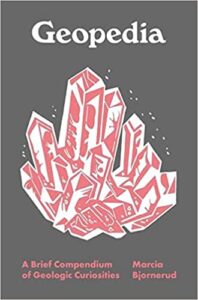Duncan White (UK)

This is a charming little book, which describes itself as an “admittedly idiosyncratic compendium of [geological] words and phrases chosen because they are portals into larger stories”.
It succeeds brilliantly at its professed goal, combining a great deal of information, education (I suspect that no-one, not even a professional geologist, will know every term – certainly I learned a lot), and a gentle sense of fun, brought out very nicely by some attractive and humorous illustrations. (The latter are by Haley Hagerman and are excellent.)
Its basic format is a miniature dictionary – an alphabetical list of geological/geographical words (or phrases), plus, for each term, a useful pronunciation guide where it’s not obvious, a amusing one-line summary, and the term’s full definition.
Actually, “definition” is not the right word – the vast majority of entries contain a wider discussion of the term in its context, its history and coinage, facts of interest, and links to related terms. So, let’s call them “descriptions” instead of definitions.
These descriptions are charming, informative and funny – and, of course, they are the backbone of the book. Let’s pick an example to explain what I mean: “THALWEG”. This is not a term I knew. The description explains that it’s German for “valley way”, and that it means the winding line of greatest depth along a river in a valley – often (but not always) the middle of that river.
Ok, pretty standard stuff so far. But the description goes on to cover:
- the term’s history;
- the contextual background, that rivers have a natural tendency to meander, undercut their own banks, and give rise to Oxbow lakes. (Ok, even I had heard of those); and
- the use of rivers as regional and national borders, explaining that several international disputes have been resolved by the rigorous application of the “THALWEG PRINCIPLE” – the idea that all river borders must follow the THALWEG, rather than the middle of the river, or wherever one side in a dispute want it to be.
Having covered all that ground, we’re still not finished with “THALWEG”. The description goes on to talk about the famous nineteenth century American author, Mark Twain, who had early experiences as a Mississippi river boat pilot. It then reveals that his name was a pseudonym (I knew that and could probably have remembered his real name if pressed – Samuel Clemens), and finally reveals that the name, “Mark Twain”, wasn’t chosen at random, but because it was Mississippi boat pilot slang for “the river is two fathoms deep here”.
I certainly didn’t know that, and I wonder how many of you did. Only one of my friends and acquaintances have known this! But you do know this now – and there are many similar nuggets of fascinating information awaiting you in this fascinating little book.
Note: I reviewed an uncorrected proof version of this book. There were several spelling mistakes, but I assume that it would be unfair to criticise those, as they will most likely be spotted and removed by publication.
Geopedia: A Brief Compendium of Geologic curiosities, by Marcia Bjornerud (with illustrations by Haley Hagerman), Princeton University Press (2022), 200 pages (hardcover), ISBN-10: 0691212570.


